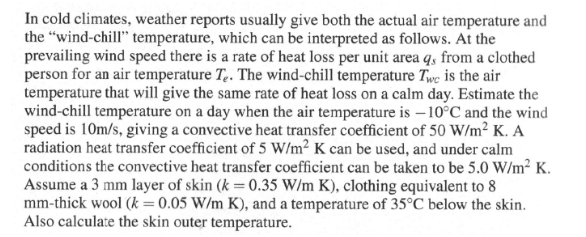In cold climates, weather reports usually give both the actual air temperature and the "wind-chill" temperature, which can be interpreted as follows. At the prevailing wind speed there is a rate of heat loss per unit area q, from a clothed person for an air temperature Te. The wind-chill temperature Twe is the air temperature that will give the same rate of heat loss on a calm day. Estimate the wind-chill temperature on a day when the air temperature is -10°C and the wind speed is 10m/s, giving a convective heat transfer coefficient of 50 W/m² K. A radiation heat transfer coefficient of 5 W/m² K can be used, and under calm conditions the convective heat transfer coefficient can be taken to be 5.0 W/m² K. Assume a 3 mm layer of skin (k = 0.35 W/m K), clothing equivalent to 8 mm-thick wool (k = 0.05 W/m K), and a temperature of 35°C below the skin. Also calculate the skin outer temperature.
In cold climates, weather reports usually give both the actual air temperature and the "wind-chill" temperature, which can be interpreted as follows. At the prevailing wind speed there is a rate of heat loss per unit area q, from a clothed person for an air temperature Te. The wind-chill temperature Twe is the air temperature that will give the same rate of heat loss on a calm day. Estimate the wind-chill temperature on a day when the air temperature is -10°C and the wind speed is 10m/s, giving a convective heat transfer coefficient of 50 W/m² K. A radiation heat transfer coefficient of 5 W/m² K can be used, and under calm conditions the convective heat transfer coefficient can be taken to be 5.0 W/m² K. Assume a 3 mm layer of skin (k = 0.35 W/m K), clothing equivalent to 8 mm-thick wool (k = 0.05 W/m K), and a temperature of 35°C below the skin. Also calculate the skin outer temperature.
Principles of Heat Transfer (Activate Learning with these NEW titles from Engineering!)
8th Edition
ISBN:9781305387102
Author:Kreith, Frank; Manglik, Raj M.
Publisher:Kreith, Frank; Manglik, Raj M.
Chapter5: Analysis Of Convection Heat Transfer
Section: Chapter Questions
Problem 5.40P
Related questions
Question

Transcribed Image Text:In cold climates, weather reports usually give both the actual air temperature and
the "wind-chill" temperature, which can be interpreted as follows. At the
prevailing wind speed there is a rate of heat loss per unit area q, from a clothed
person for an air temperature Te. The wind-chill temperature Twe is the air
temperature that will give the same rate of heat loss on a calm day. Estimate the
wind-chill temperature on a day when the air temperature is -10°C and the wind
speed is 10m/s, giving a convective heat transfer coefficient of 50 W/m² K. A
radiation heat transfer coefficient of 5 W/m² K can be used, and under calm
conditions the convective heat transfer coefficient can be taken to be 5.0 W/m² K.
Assume a 3 mm layer of skin (k = 0.35 W/m K), clothing equivalent to 8
mm-thick wool (k = 0.05 W/m K), and a temperature of 35°C below the skin.
Also calculate the skin outer temperature.
Expert Solution
This question has been solved!
Explore an expertly crafted, step-by-step solution for a thorough understanding of key concepts.
Step by step
Solved in 3 steps with 3 images

Knowledge Booster
Learn more about
Need a deep-dive on the concept behind this application? Look no further. Learn more about this topic, mechanical-engineering and related others by exploring similar questions and additional content below.Recommended textbooks for you

Principles of Heat Transfer (Activate Learning wi…
Mechanical Engineering
ISBN:
9781305387102
Author:
Kreith, Frank; Manglik, Raj M.
Publisher:
Cengage Learning

Principles of Heat Transfer (Activate Learning wi…
Mechanical Engineering
ISBN:
9781305387102
Author:
Kreith, Frank; Manglik, Raj M.
Publisher:
Cengage Learning